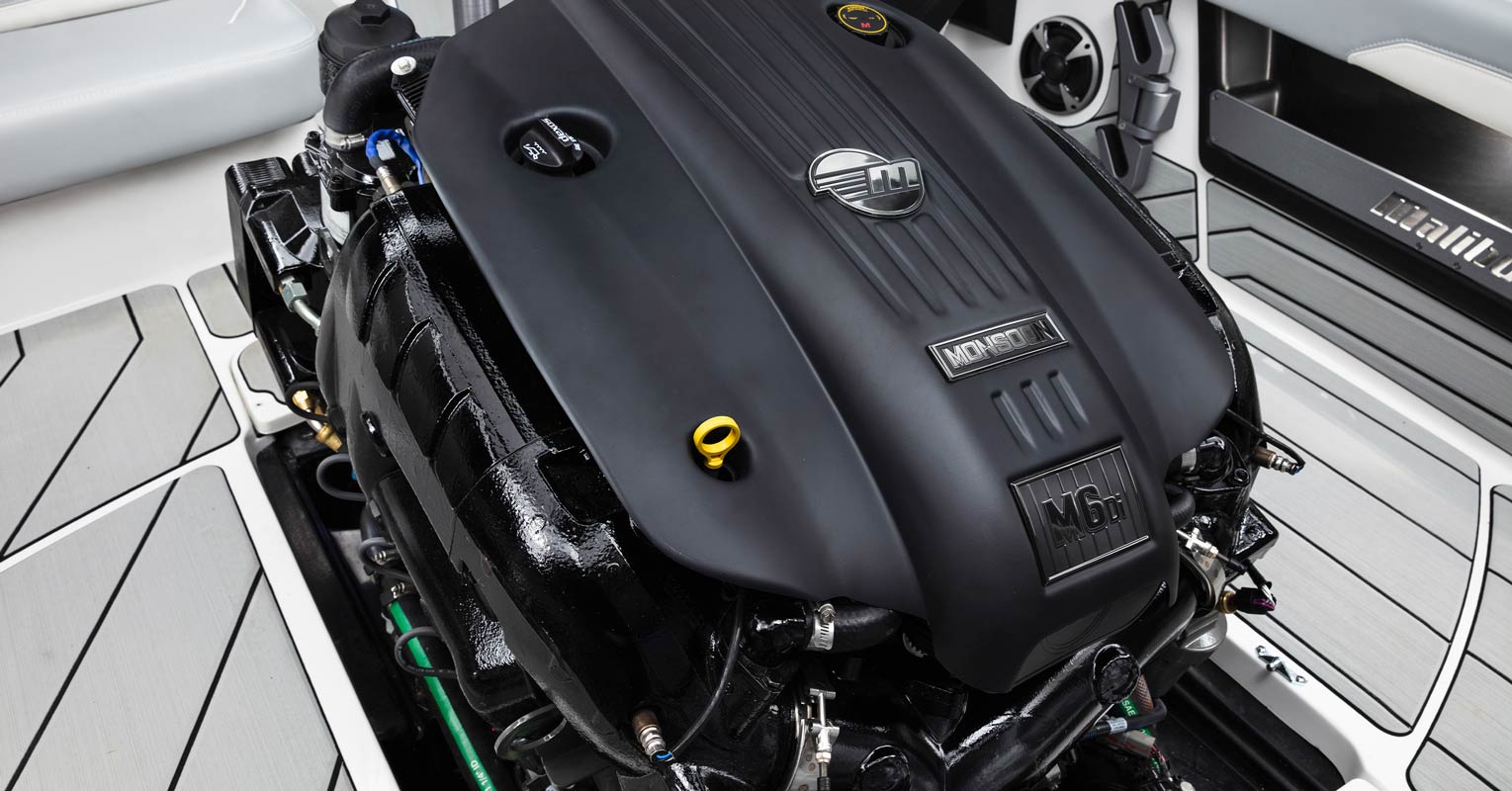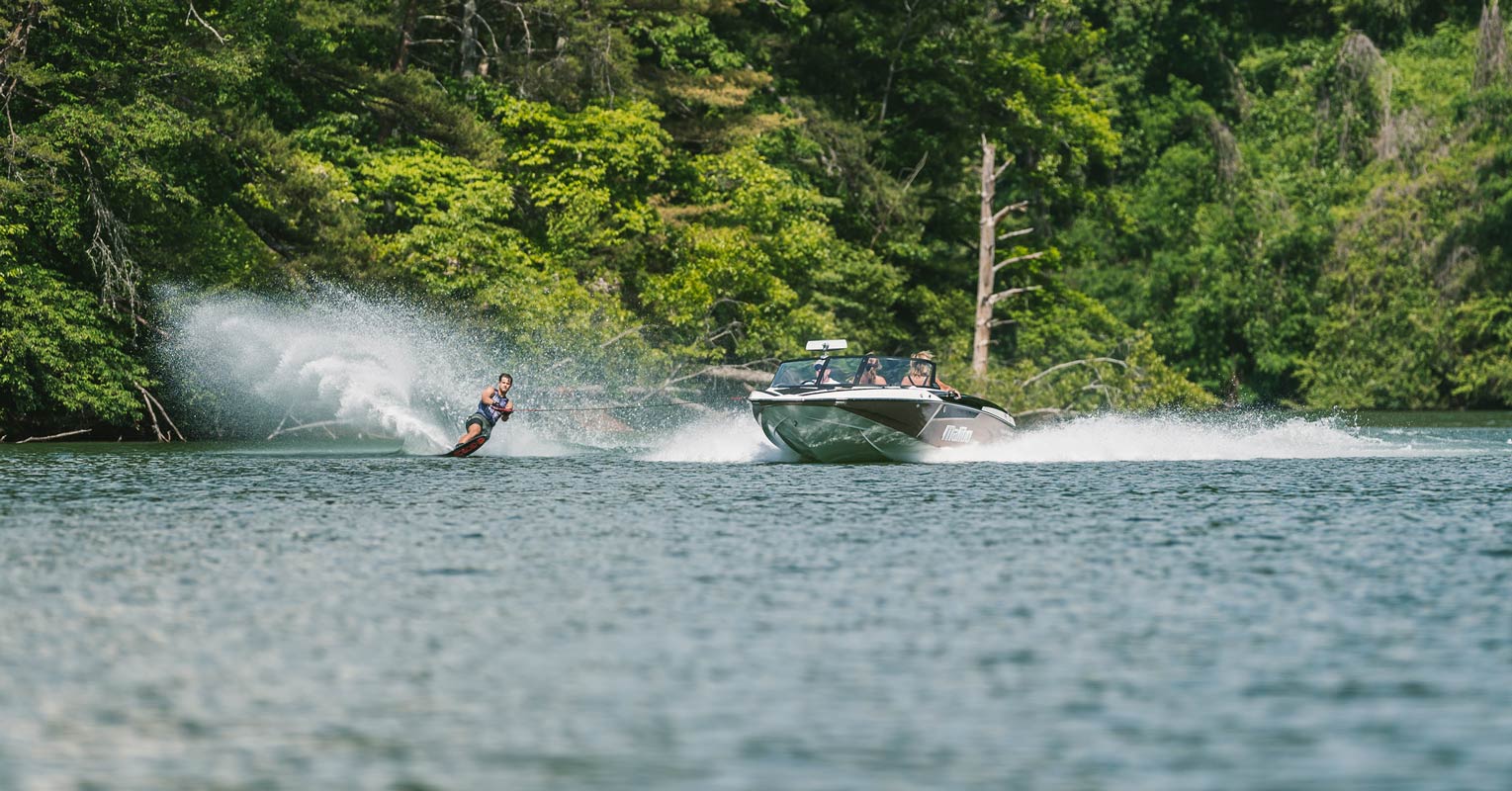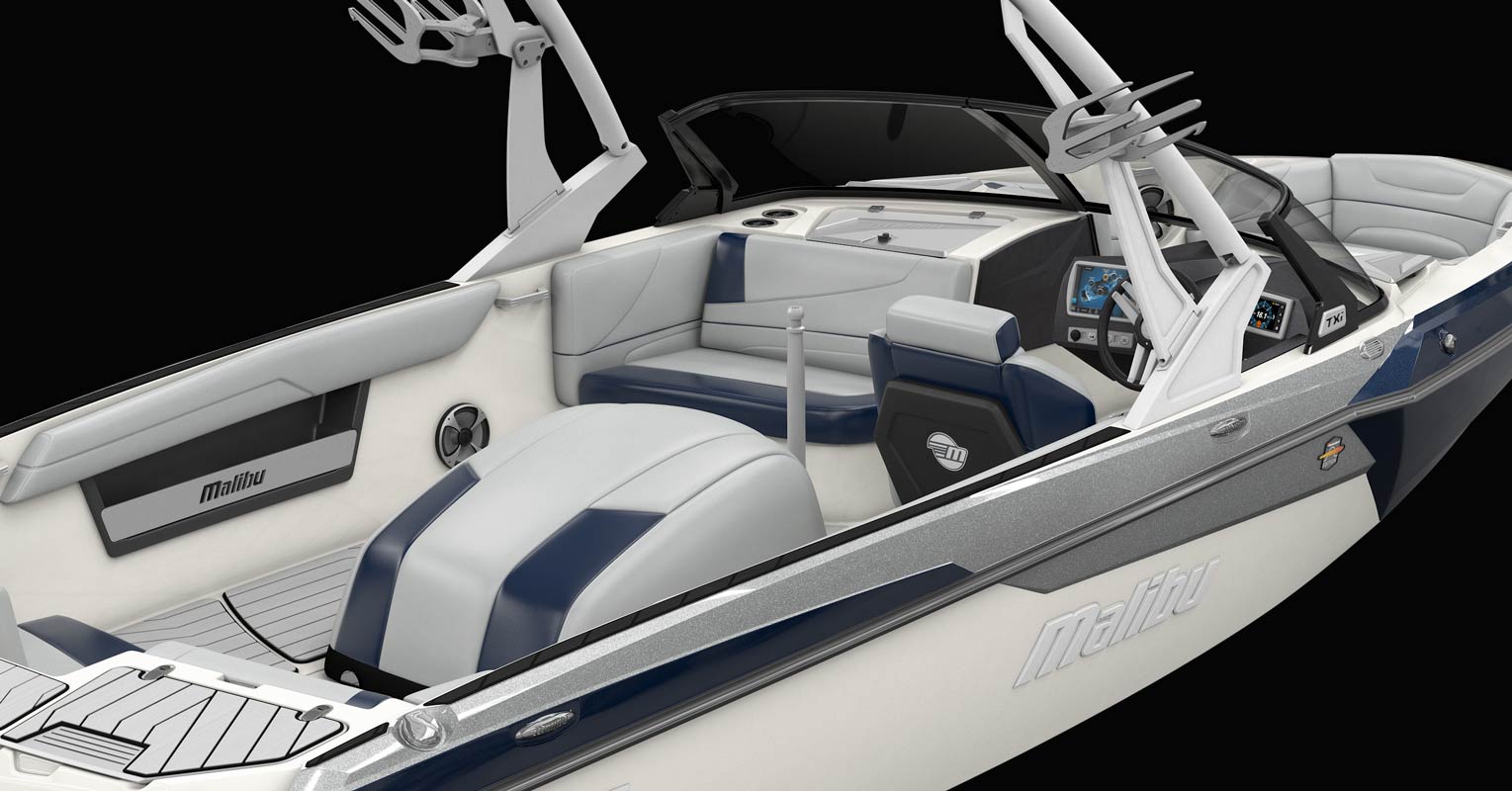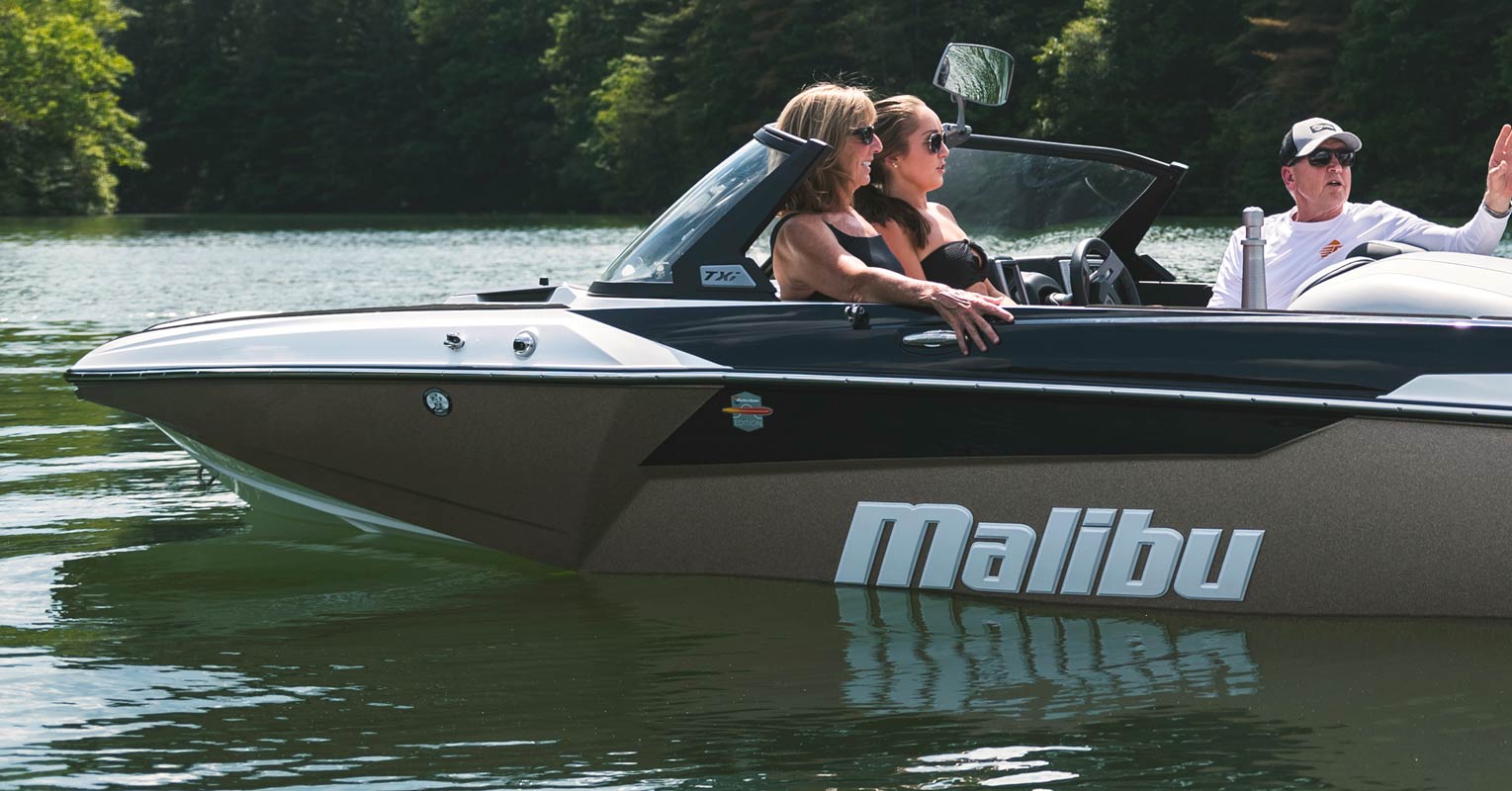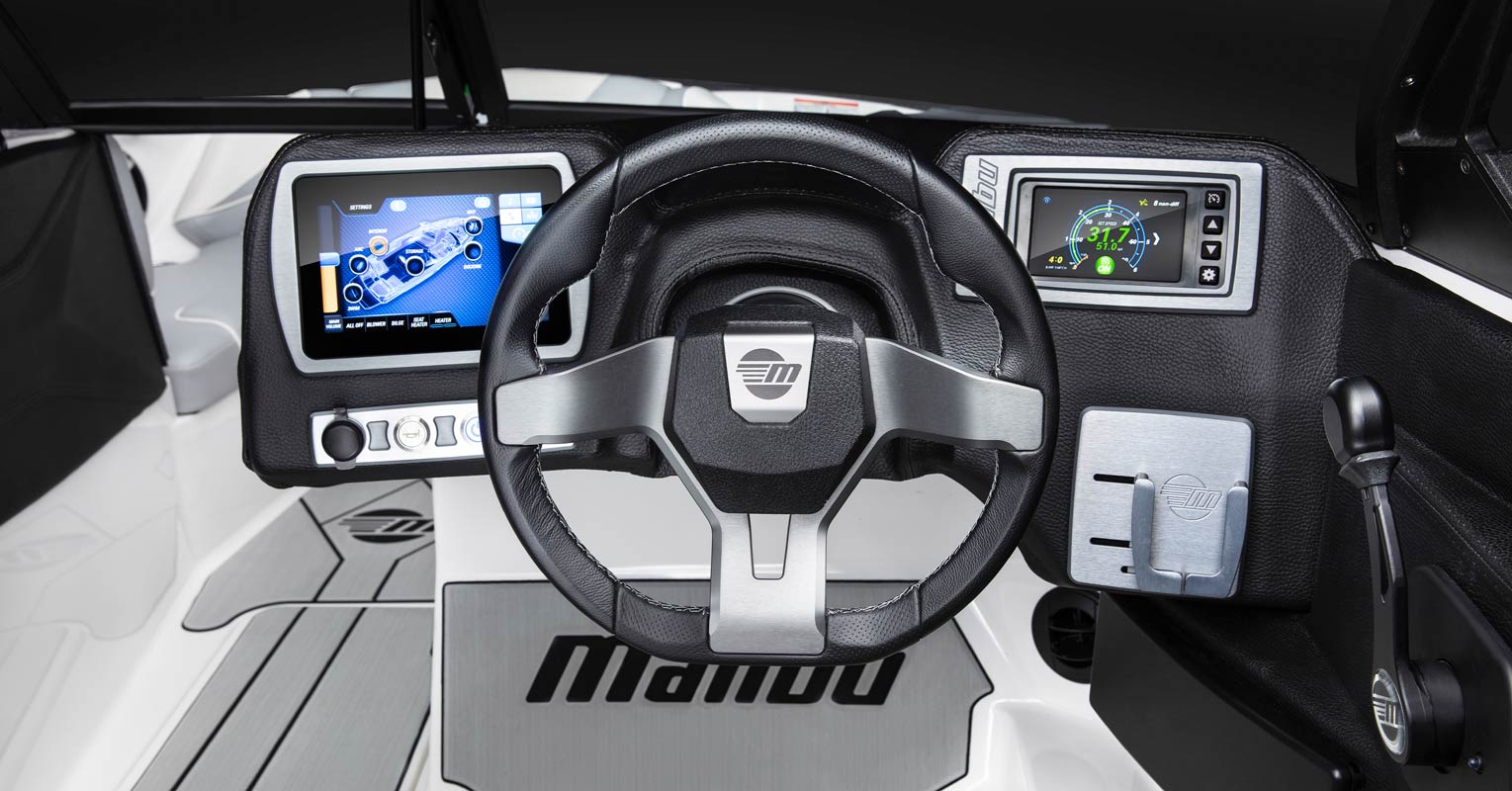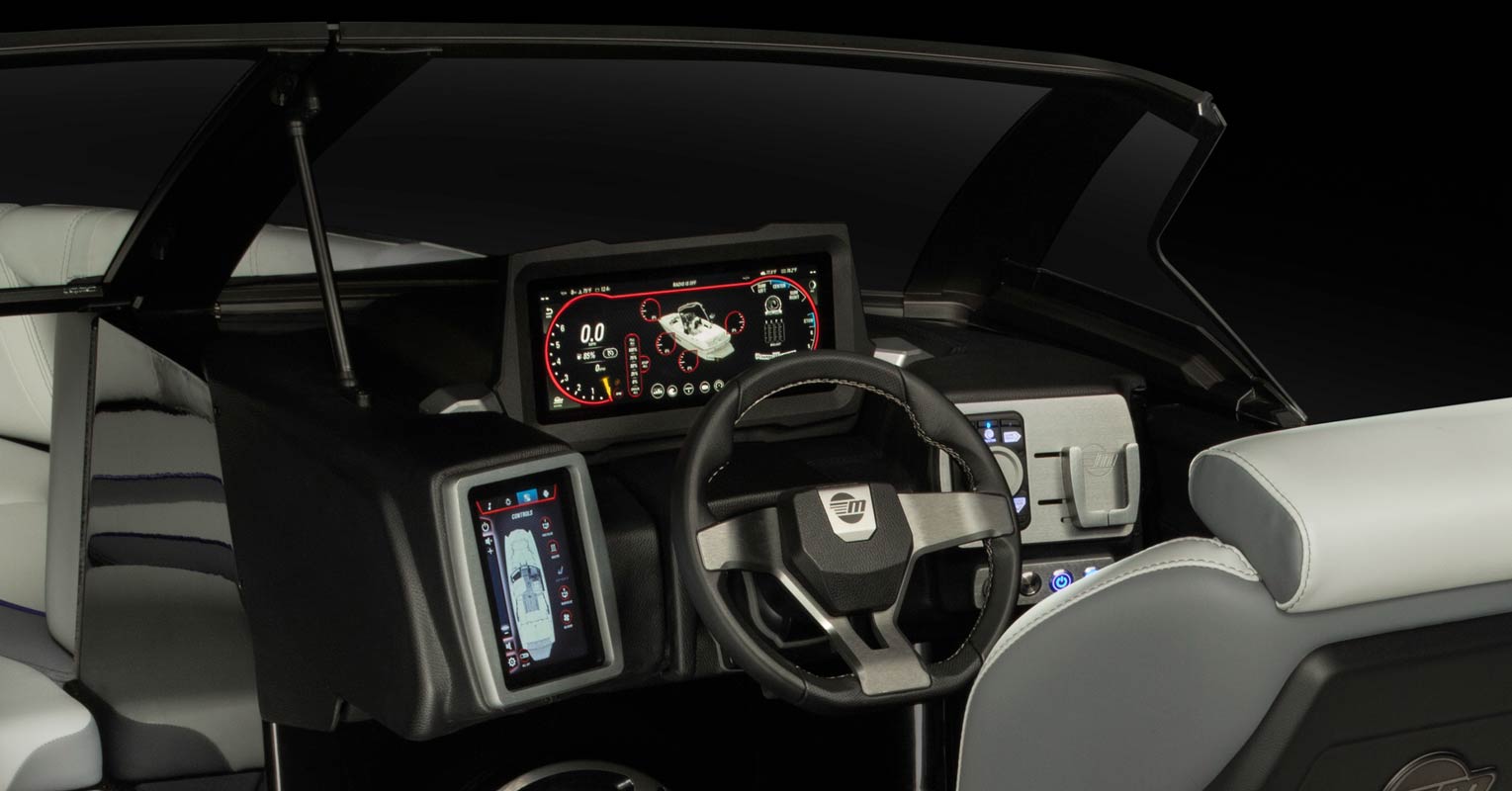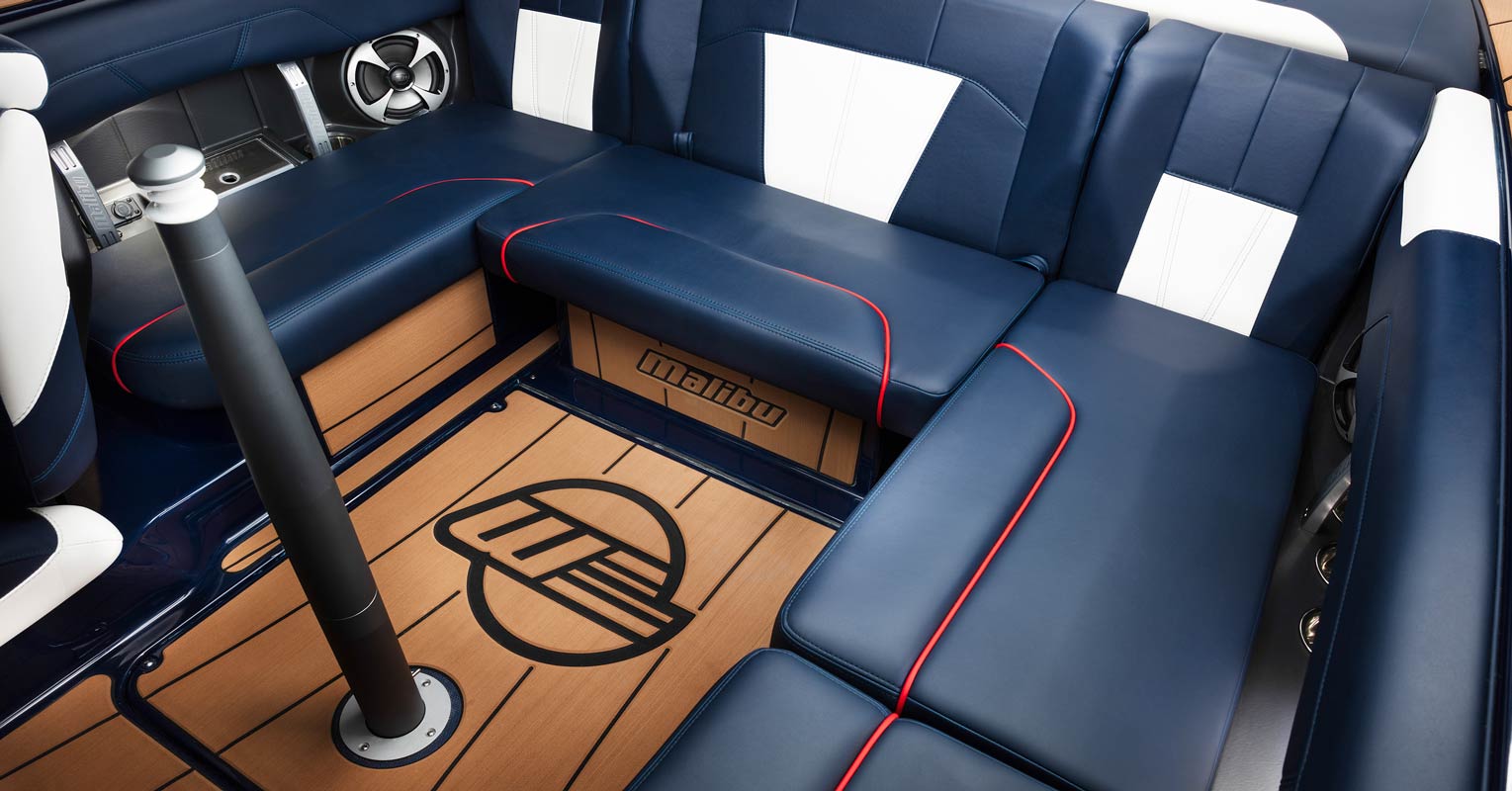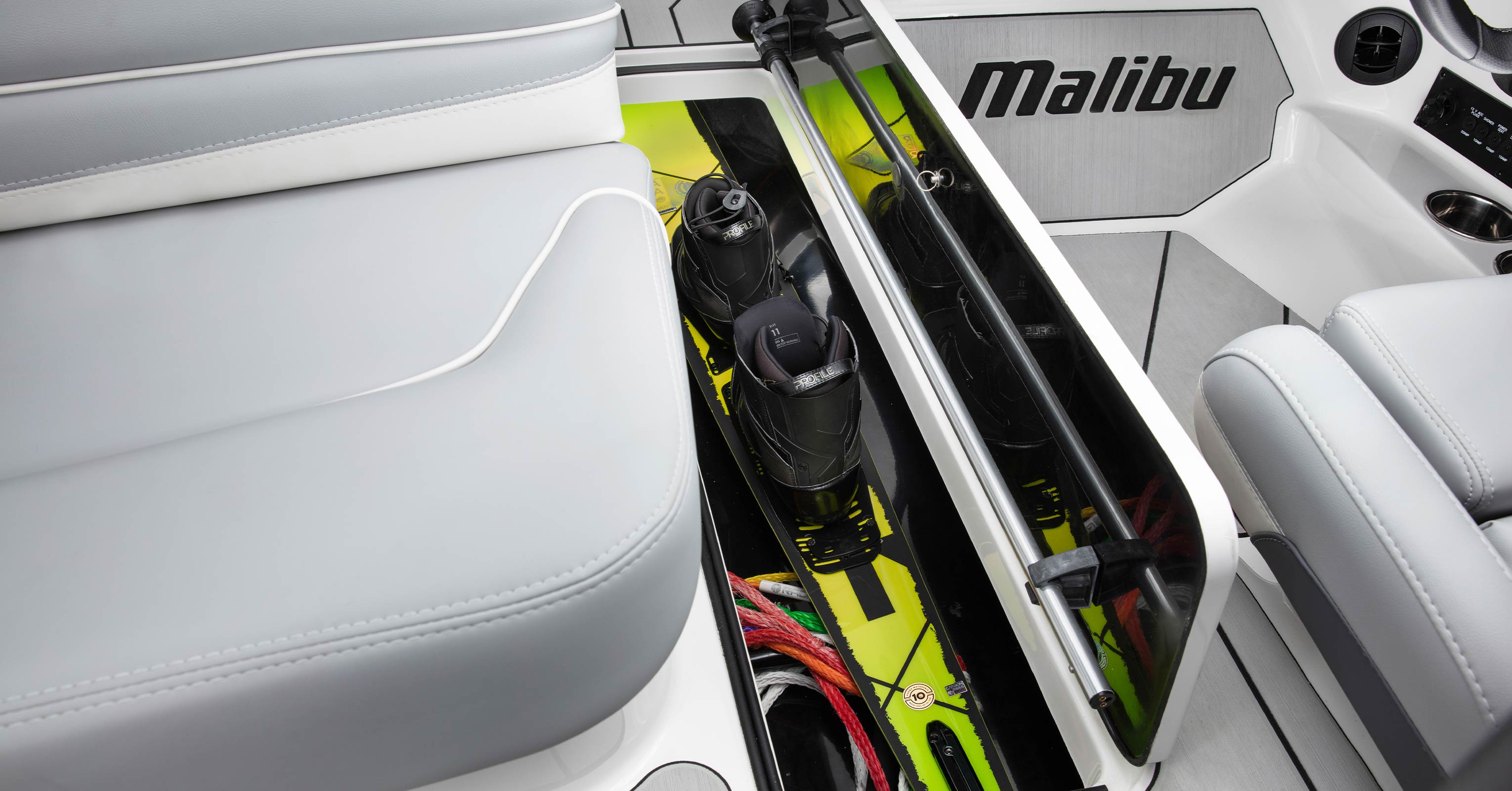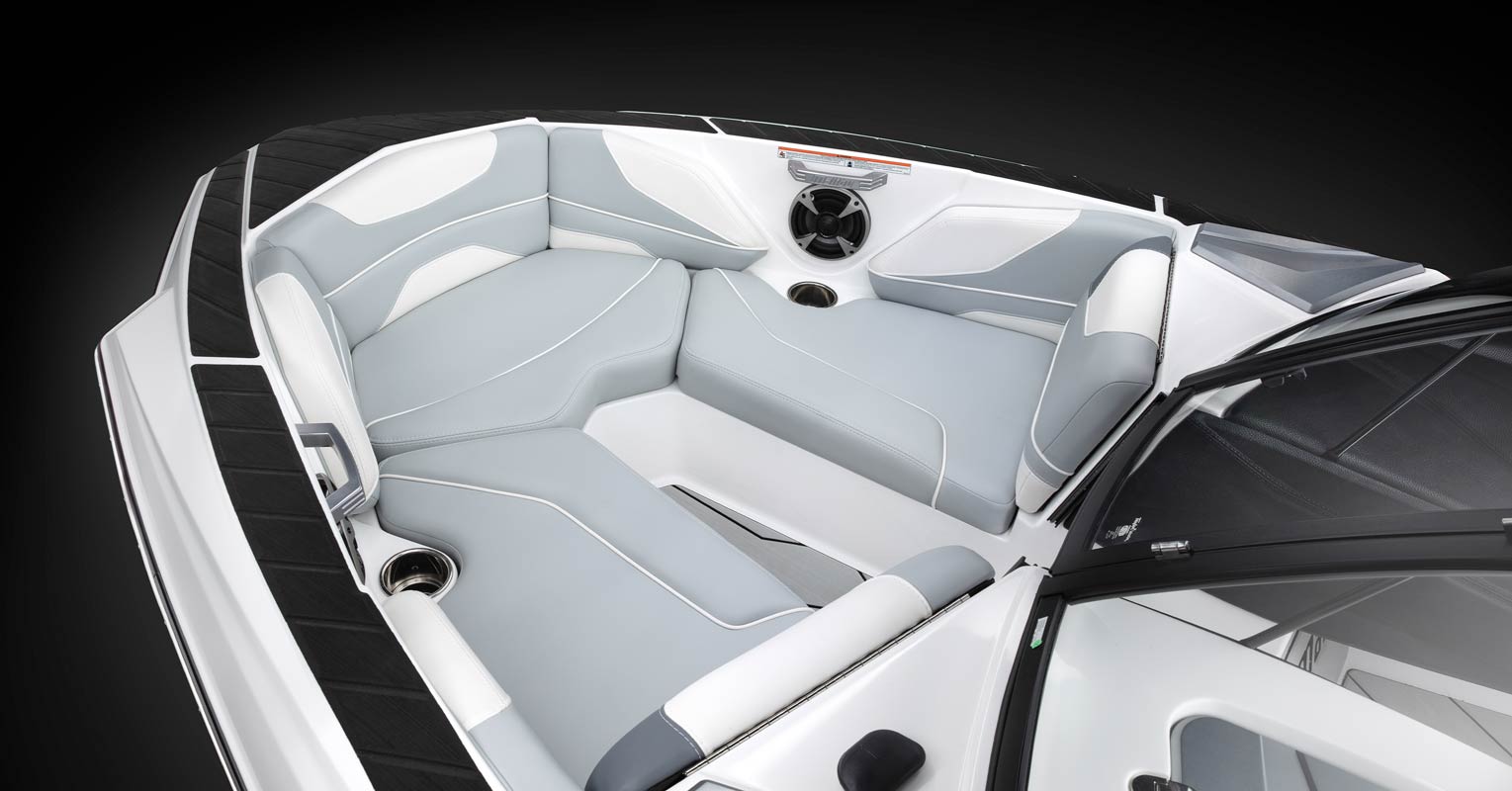Water Skiing
What makes the World’s best Water Ski Session?
Equally as important as wake size and softness, is the overall comfort experience and the multitude of unique boat features that provide consistent pulls and performances in slalom, trick, and jump skiing. In this article, you will learn everything you need to know about water skiing so that you'll be skiing on the lake all summer long.
Keep reading to learn all about:
• What Makes the World’s Best Water Ski Boat?
• The Malibu TXi
• Waterski Innvovations and more
• The Malibu 20 VTX
• How to Waterski
• How to Drive for a Waterski Deep-Water Start
• How to Turn on Waterskis
• Picking the Best Ski for You
What Makes the World’s Best Water Ski Boat?
What makes the world’s best ski boat? At first thought people may say it’s all about the flat and soft wake, but there are many crucial factors that define the pinnacle of ski boats. Equally as important as wake size and softness, is the overall comfort experience and the multitude of unique boat features that provide consistent pulls and performances in slalom, trick, and jump skiing. With water skiing’s versatility variables such as differing and ever-changing speeds; rope lengths; athlete ability; tracking execution; engine power demands; and the driver’s ease in delivering the ultimate skier experience, the best water ski boat must seamlessly collaborate boat design, athlete differences, and water conditions to provide the best experience possible. Saying a water ski boat is “just about the wakes” is like saying a house is all about the floor. Sure, the house’s floor is an essential part, but it’s far from the only thing a person will need to live in the house. Learn about what encompasses the best ski boats in the world, what separates Malibu from its competitors, and why the wake—as essential as it is—is just one of many considerations when deciding to purchase a ski boat.
Performance
It’s not the only thing, but it’s sure important. That’s why at Malibu, we’ve had our waterski wake design and accompanying features dialed in since the company’s inception in 1982. Malibu was started by a group of water skiers who wanted a better boat than the market offered, and that passion has fueled decades of relentless innovation Malibu is known for throughout all their models. The Response TXi’s high level of performance for slalom, trick, and jump skiing is evident in the results produced year after year…with 13 World Slalom Records at the elite level, multiple National Age Divisions records in Slalom, Trick, and Jumping, countless personal bests in all three events for young and old competitors around the World, and outstanding performances year after year by professional athletes at the Malibu Open all prove the “truth is on the water” with the Response TXi. But, what goes unnoticed is all the daily outstanding performance being made behind this one-of-a-kind machine day after day across the nation and world from skiers who love the boat’s performance and wouldn't ski behind anything else. In addition, with the Wedge option for surfing, and tower option for wakeboarding, the TXi has the versatility of performing far beyond the competitive arena. It is a true mid-engine crossover ski boat with a spacious interior that drives like a sports car, but is still capable of towing beginning surfing, wakeboarding, and water toys for a day of fun with family and friends.
In the world of waterskiing, performance is recognized, and it’s all about being tournament approved by the governing bodies of USA WaterSki and the sub-component for three event skiing, AWSA (American Water Ski Association). Becoming an approved towboat through extensive testing by USA WaterSki is the gold standard in the world of recreational, amateur, and professional skiing. The Malibu Wakesetter VTX and Malibu Response TXi have met and exceeded that standard. But, the Response TXi also achieves the highest approval as an AWSA-Approved Tournament Towboat, allowing the TXi to pull tournament events all across the world while strongly handling the changing demands of varying lake lengths, lake depths, climate, and altitudes from sea level to over 5000 feet. It is paramount that the TXi performs strong, without compromise, at high altitudes. Through on-the-water testing, the expertise of Malibu engineers, and choices in engine upgrades, the TXi is capable of performing at any ski site across the world.
Malibu Response TXi
Malibu Response TXi

T-Cut Diamond Hull
Tracking Fins
Customizable
Malibu Open Edition
With 13 world records under its belt and the best skiers in the world using it on a daily basis, the TXI is the most complete slalom, trick and jumping machine available today. With the legendary T-Cut Diamond Hull as the foundation, the TXi combines hardcore features with Malibu luxury and the innovation that can only come from decades of on-water use to make the most iconic waterski boat in the industry. Here are the highlights of what makes this boat so special.
Tracking
Large, well-placed tracking fins are key to a perfect pull. You can’t be at your best if the boat is swaying from side to side, which is why the TXi holds a laser-straight line—something that will always matter whether it’s a recreational skier in open water or a world-class skier going for a new record in the slalom course, or pushing the limits for a long distance jump.
Zero Off and Much More
The Malibu Open Edition of the TXi is fully decked out with everything a tournament skier would need, straight from the dealer. The TXi remains the only tournament-approved towboat with a true walk through to the bow and a belly ski locker area handling the storage of 2-3 additional skis. Equally as impressive, both the TXi models have available tower options that are positioned forward enough to pull any skier into world record line lengths with no interference of the side to side moving ski rope against the tower. Items like the walk through seat on either TXi model for tournament use in the trick event can also be turned around and faced forward in front of the windshield to get another seat for a small person riding in the bow. Consistency is key when it comes to the optimal slalom, trick, and jumps pull, and the unmatched best, most steady speed available is from Zero Off. The TXi is truly the most multitalented world-class ski boat on the market today.
Direct-Drive
The TXi’s direct-drive engine configuration delivers the most stable platform for a skier to pull from. With the engine situated in the middle of the boat, the center of gravity is seated exactly where the pull is coming from when you turn, which means it’s less apt to sway the boat from side to side on hard turns.
Waterski Innovations
The Malibu Wakesetter VTX
The Malibu Wakesetter VTX

Removable Center Pylon
The Malibu 20 VTX’s recreational waterski potential is through the roof.
Malibu Cut Diamond Hull
The Cut Diamond Hull is a running surface so versatile that it’s tournament approved for waterskiing, yet still able to churn out a driving, powerful surf wave and perfectly-formed wakeboard wakes—all with push-button customization thanks to Malibu’s patented wake innovations. If your family wants smooth waterski wakes on buttery mornings followed by endless sets of churning wakesurf waves in the afternoon capped off with an evening wakeboard session, the Cut Diamond Hull is the best all-around running surface. The Cut Diamond Hull along with the VTX’s size make it an ideal platform for watersports.
Malibu Monsoon M5DI and M6DI Engines
Direct injection engine technology is one of the secrets behind the best waterski boats in the world. Direct injection allows the Malibu Monsoon engines to drive the VTX with more power and torque than anything else in its class while still delivering lowering emissions, along with outstanding fuel economy and reliability you can count on summer after summer. The low-end torque only available in a direct injection engine means more power where you need it, when you need it. This translates into smoother, more controlled deep water starts and a more consistent pull, since the engine isn’t working as hard. It also allows for a more precise fuel burn that saves money at the pump.
GPS-Based Speed Control
A hull and engine are only as good as the throttle consistency. Gone are the days of trying to watch RPMs to maintain a perfect speed for the perfect pull. Now, the Malibu Command Center takes over with satellite-based Zero Off speed control that pin points your boat’s position for more accurate, consistent speed control. When the engine is fed straight from the computer that’s updating on a split-second basis, your pull will feel smoother than ever. With the 12” touch screen interface on the Malibu Command Center, incremental adjustments are at your fingertips for fine-tuning speeds as well.
Center Tow Pylon
Whether you’re a serious buoyhead looking for your next personal best or a recreational skier looking to have some fun on combo skis, a center tow pylon is going to enhance your waterski experience. A center tow pylon translates the load of the skier pulling to the middle of the boat where its center of gravity allows the hull to track the straightest. If you’ve ever had the feeling of driving a skier and having to correct with the steering wheel every time they make a hard turn, you know what it’s like to not have a center tow pylon. The VTX’s optional Response tower accommodates short lines so the waterski rope never gets caught up in the tower’s stanchions when using the center tow pylon. This is something for serious skiers to watch out for with other brands that may have put a center pylon on a boat that wasn’t made for skiing. The best part? When you’re done skiing, just remove the pylon and store it under the seats for unencumbered space the rest of the day.
Malibu Comfort & Luxury
HOW TO WATERSKI
How to Drive for a Waterski Deep-Water Start
Waterskiing is the original towed watersport, and it’s as fun now as it was when show skiers strapped on wooden skis at Cypress Gardens back in the day. A few laps around the lake on two skis is a great platform for learning to carve, which can be leveled up to slalom when the skier is ready. Here are some tips to get up on waterskis in no time. Let’s start with some driving tips.
Safety First
As with any watersport, safety is the number one priority. Make sure every crew member has a well-fitting, US Coast Guard-approved life jacket. Kids 12 and under should wear theirs at all times, so try to pick one made from a material like neoprene that keeps them comfortable all day. You should also have a throwable flotation device on the boat, and in some states you need to have a watersports flag to let other boats know when your rider is down as well. When driving, stay at least 200 feet away from docks, pilings, shallow areas and other vessels, whether they are powered or not. When your skier falls, circle back to them at an idle speed unless it’s an emergency and always try to keep them on the boat’s driver side so you can see exactly how far you are from them. Try to swing fairly wide when you turn back around to avoid running over the waterski rope. Always drive facing forward, keeping your attention on other boats and obstacles in front of you; allow the spotter to tell you what’s happening with the skier rather than turning around to see them.
How to Drive for a Waterski Deep-Water Start
A deep-water start is the first step on the waterski journey for many people. It’s a great way to ease into the feel for the way the skis will handle on the water, and when done properly it can be fairly simple. But these tips are critical to a good experience. First off, make sure you always tension the waterski rope slowly. Your boat has a lot of power so you’re not going to need all of it. The key is to wait until the skier says “hit it,” (“go” sounds too much like “no” and could cause confusion), tension the line with short nudges of forward throttle, and then gradually push the throttle down until you’re at waterski speed.
How Fast Should You Drive for Waterskiing?
Speeds range from 18-36 miles per hour, but it completely depends on the skier and what they want to accomplish. Go as slow as possible while still keeping them on top of the water until they get the hang of it, then gradually increase the speed as they signal you. The signal for increasing speed is a thumbs up and the signal for decreasing speed is a thumbs down.
What Direction Should You Drive for Waterskiing?
Your driving direction for waterskiing will vary based on your waterway. Some lakes have an established circle everyone goes in, for example, and that may be listed at the launch ramp from the lake association. Some waterways don’t have an established direction, and you just find some relatively calm water. If other boats are already skiing that area, it’s best to trade sets with them or go in the same direction to avoid rollers that will mess up the water for everyone. Try to drive in a relatively straight line whenever possible; your skier will have a much better pull when the boat isn’t constantly turning. Arrange a hand signal for when you’re going to turn around or make a sharp turn so the skier knows what’s happening.
How to Do a Waterski Deep-Water Start
The feeling of gliding on top of the water on a pair of skis is like no other sport, and when you get up on two skis you can graduate to a single slalom ski. From there, the you can get into the course and challenge yourself by shortening the line. Your waterski addiction will be in full swing! But to do all this, first you need to learn a deep-water start. Here are some tips to get up your first time.
How to Get Up on Waterskis
Getting up on waterskis is really easy when you get the hang of it, and it all comes down to knowing a few simple things. On the VTX or an equipped TXi, you can attach your rope to the tower’s main tow point so the extra height helps lift you out of the water. You can either put on your skis on the boat’s platform with the fins hanging off the side, or put your skis on in the water. When you have your skis on, get situated with the handle in your hands in a baseball grip. You should be in a sitting position facing the back of the boat with your ski tips in the air and the rope between your skis. Keep your knees into your chest and your heels as close to your butt as possible. This part is important because the tendency is to try to fight the boat by straightening your legs, but it makes it much more difficult to get up. Instead, stay in this balled up position and when the line is tight, tell your driver to “hit it.” The driver will slowly ease the throttle forward and the skis will start to bring you on top of the water. Stay in this crouched position until you’re completely on top of the skis and the skis are on top of the water. From here, you can stand up into an athletic stance with your core tightened. Try to avoid bending at the waist like a folding chair. Instead, keep your back straight, your shoulders back and your legs slightly bent.
How to Turn on Waterskis
Turning—or carving as it’s known in the waterski world—is all about a subtle weight shift. When you want to turn to the left, for example, you just put some more weight on your right foot while easing off on the left, and vice versa. Remember to keep your core braced, stay straight at the waist, and your legs slightly bent in an athletic stance.
How to Slalom Ski
When you want to learn to slalom ski, the best way is to start with two skis and drop one. It’s important to make sure you’re in an area where it’s safe to drop a ski. Your dominant foot (typically the one you kick a ball with) will be the foot with the slalom ski. Practice finding the rear toe harness on land. The whole process is much easier when you know where your foot needs to be, so repetition is key here. Practice getting the drop ski off your foot (it can be helpful to loosen the harness so your foot slides out easier) and moving that foot to the rear harness until the movement feels natural, then take it to the water. When you’re up and skiing on two skis, practice lifting the ski you’re going to drop. This will give you the feeling of standing on one foot, which is what will momentarily happen after you drop the ski. When you’re comfortable, slide your foot out of the harness and do the same motion you did on land, smoothly transitioning from two skis to one. You’re slalom skiing!
How to Do a Slalom Ski Deep Water Start
Getting up on a slalom ski is a little more challenging than two skis, but when you get it you’ll have it for life and you can ditch the drop ski. Start out in the same crouched position facing the back of the boat with the ski tip in the air. Put your rope on one side of the ski, it doesn’t matter which. When the line is tight, tell your driver to “hit it” and stay in this balled up position until you’re completely up. Try to keep the ski straight in front of you and resist the urge to straighten your legs. When you’re up, keep your core tight and don’t bend at the waist.
How to Turn on a Slalom Ski
When you’re ready to carve, shift your weight slightly to the side you want to go. Lean back against the rope with your shoulders back and your core tight. Remember to not fold forward at the waist or your stability will be compromised. The harder you lean, the faster you will turn, so keep your movements very small and controlled until you get the hang of it. You’ll be throwing up walls of water in no time!
Photos



Picking the Best Ski for You
There is no best ski for every skier, it’s just what you prefer, what level you’re at, and how far you want to go with the sport. When starting out, it’s best to go with a combo ski set that has two beginner skis, one set up for slalom with a rear toe harness. This allows you to do all the combo skiing you want as well as recreational slalom skiing. A typical combo ski set will accommodate a wide weight range. A rule of thumb is that a 160-pound skier will use a 66” ski, and for every additional 20 pounds, the skis should increase by two inches. When starting out, look for a wide ski that will allow you to slow the boat’s speed down and still have plenty of stability. Slalom-specific skis will have two bindings and are much narrower than combo skis. These are great when you’re ready to really start getting aggressive with turns, but they will be much more difficult to learn on. Popular brands include O’Brien, Connelly, HO, along with plenty others.
